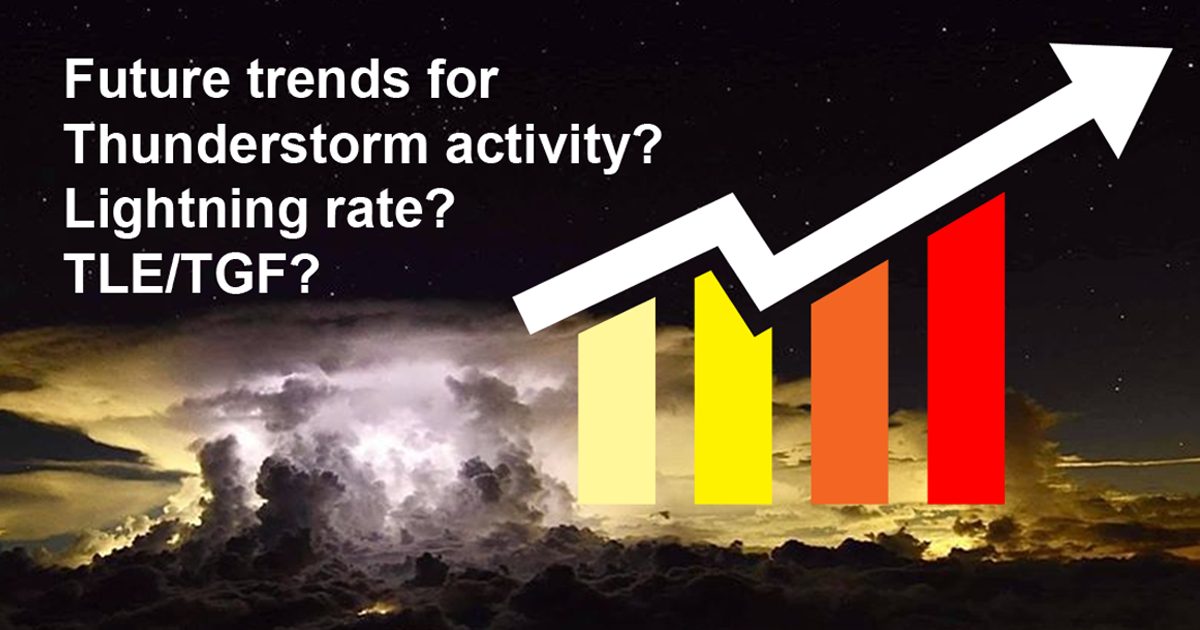- 2.3Impact Factor
- 4.9CiteScore
- 17 daysTime to First Decision
Future Trends of Our Atmospheric Electric Environments
This special issue belongs to the section “Upper Atmosphere“.
Special Issue Information
Dear Colleagues,
Global climate models have suggested that the frequency of thunderstorms and their intensity are likely to increase in the future. Cloud electrification through microphysics processes should clarify the relationship between faster updrafts and lightning frequency. The meteorology and climatology reanalysis with observation and numerical modeling will improve forecasting of a severely convective system. We should further inspect their causes and effects on lightning activities, transient luminous events (TLEs), and terrestrial gamma-ray flashes (TGFs). Further, some atmosphere drivers, such as their radiated energy and gravity waves, may be involved in coupling with the middle and upper atmosphere through atmospheric transport processes, lightning-related perturbations in the middle/upper atmosphere, temperature changes, gas concentration variations, chemical changes, and coupling processes from the lower atmosphere to the near-earth space environment. We invite papers on topics related to thunderstorms, lightning, and transient luminous events. Enhancing our understanding of future trends or climate change for our atmospheric electric environment is of great interest. This also includes findings dealing with thunderstorm dynamics, lightning statistical studies, observation/campaign on transient luminous events, or airglow/aurora monitoring for tide and gravity wave phenomena. Statistical/case studies on global/regional or rural/urban for lightning/TLEs/TGF trends responding to severe weather conditions or climates changes are of particular interest.
Prof. Dr. Cheng-Ling Kuo
Prof. Dr. Sato Mitsuteru
Guest Editors
Manuscript Submission Information
Manuscripts should be submitted online at www.mdpi.com by registering and logging in to this website. Once you are registered, click here to go to the submission form. Manuscripts can be submitted until the deadline. All submissions that pass pre-check are peer-reviewed. Accepted papers will be published continuously in the journal (as soon as accepted) and will be listed together on the special issue website. Research articles, review articles as well as short communications are invited. For planned papers, a title and short abstract (about 250 words) can be sent to the Editorial Office for assessment.
Submitted manuscripts should not have been published previously, nor be under consideration for publication elsewhere (except conference proceedings papers). All manuscripts are thoroughly refereed through a single-blind peer-review process. A guide for authors and other relevant information for submission of manuscripts is available on the Instructions for Authors page. Atmosphere is an international peer-reviewed open access monthly journal published by MDPI.
Please visit the Instructions for Authors page before submitting a manuscript. The Article Processing Charge (APC) for publication in this open access journal is 2400 CHF (Swiss Francs). Submitted papers should be well formatted and use good English. Authors may use MDPI's English editing service prior to publication or during author revisions.
Keywords
- atmospheric electricity
- thunderstorm
- lightning
- transient luminous events
- terrestrial gamma-ray flash

Benefits of Publishing in a Special Issue
- Ease of navigation: Grouping papers by topic helps scholars navigate broad scope journals more efficiently.
- Greater discoverability: Special Issues support the reach and impact of scientific research. Articles in Special Issues are more discoverable and cited more frequently.
- Expansion of research network: Special Issues facilitate connections among authors, fostering scientific collaborations.
- External promotion: Articles in Special Issues are often promoted through the journal's social media, increasing their visibility.
- e-Book format: Special Issues with more than 10 articles can be published as dedicated e-books, ensuring wide and rapid dissemination.

